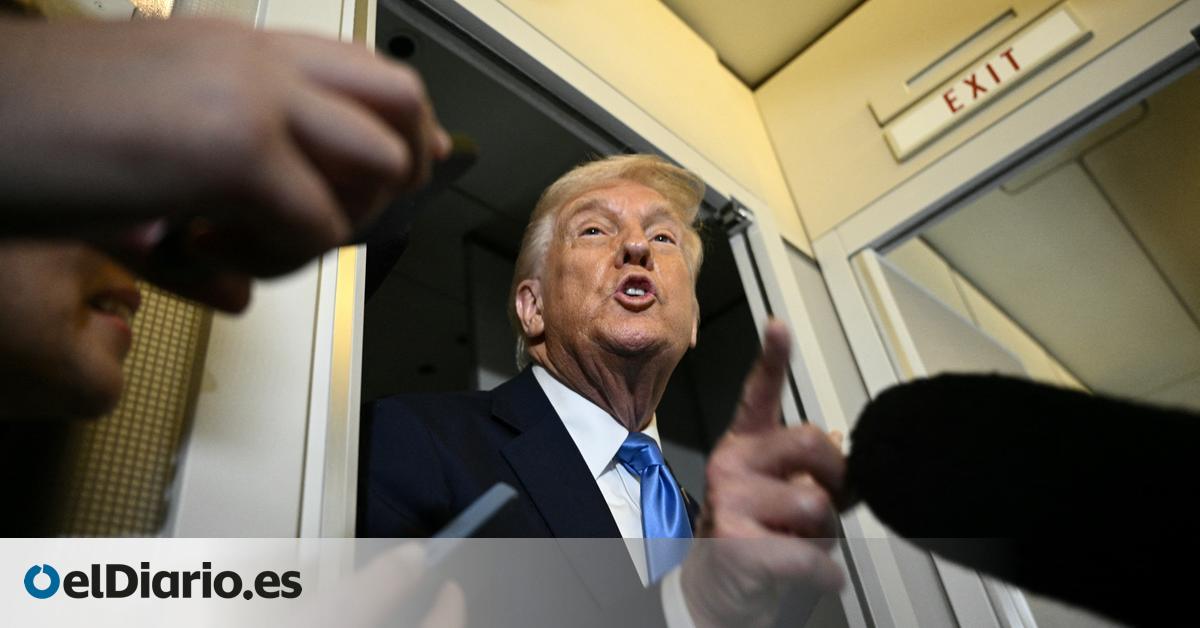
On the eve of the entry into force of the tariffs promised by Donald Trump, in the streets of Washington you can see marques paid by Canada with the phrase: “Tariffs are taxes on the US working class.” In spite of the hard impact that the rates will have in the pocket of the Americans – something that Trump himself has come to recognize as a small “turbulence” -, the Republican has announced to Bombo and dish the entry into force of the taxes this Wednesday, April 2, such as the “Liberation Day.” If it meets the promise to impose rates against the long list of countries mentioned, the current commercial war will enter a new stage unprecedented and with unimaginable consequences.
The US president has converted world stock indices into a downward roller mountain with its erratic and chaotic trade war. Those called by Trump Reciprocal tariffs, which must enter into force from midnight on Tuesday, are the final traca of the Trump plan to, supposedly, achieve other political objectives, such as promoting the reindustrialization of the country and turning it into an attractive destination for foreign manufacturers. Inspired by the protectionist policies of the late nineteenth century of former president William McKinley, Trump has been defending tariffs from the electoral campaign as the solution to all the problems that, according to him, affect a nation on the edge of the economic collapse.
In February, Trump signed a memorandum ordering his team to propose an answer to all tariffs on US products, including taxes that are “unfair, discriminatory or extraterritorial” – where European VAT would be included. At that time an exact figure was not set, but the possibility of applying tariffs of up to 30% is considered if the president includes VAT in his calculations. At the end of February, Trump said he would impose 25% tariffs on the European Union in “general terms”, after it was willing to lower the taxes to US cars and make other concessions.
On Sunday, from the Air Force One, Trump said that “it will begin with all countries,” although he said that the levies would be more generous than the commercial partners with the United States have been. The constant changes of opinion of the president add even more volatility to an environment already unstable. Last week, the Treasury Secretary, Scott Besent, assured Fox Business that the most affected countries will be 15% of the nations that contribute the most to the United States trade deficit and impose higher tariffs.
The “15 dirty”
“There is what we would call the ’15 dirty ‘ [15 Dirty]”, Besent said in reference to this 15%, stating that these countries impose tariffs and other commercial barriers unfair to US products. “It is 15% of the countries, but represents a large part of our commercial volume.”
The White House has not published the list of the countries that make up the “15 dirty”. However, according to The Wall Street Journalthe nations and blocks with the largest commercial deficits with the United States are China, the EU, Mexico, Vietnam, Taiwan, Japan, South Korea, Canada, India, Thailand, Switzerland, Malaisia, Indonesia, Cambodia and South Africa.
In the interview, Besent also suggested the possibility that the “Liberation Day” tariffs end up being lower than what was initially proposed. It is an statement that would go in line with Trump’s statements. Even so, last Thursday the US president made a bomb announcement that was notified to the press just three hours in advance, in which 25% tariffs were decided to “all” cars not made in the United States as of April 2.
If there is a pattern that is repeated within Trump’s tariff chaos, it is to reculate, change criteria or grant truces or exceptions. Mexico and Canada know it well with their 25%tariffs, which have been postponed up to twice: the first, hours before their entry into force, and the second, shortly after they became effective. In the case of the so -called reciprocal tariffs, when Trump was asked on Friday if he hoped to implement any exemption for vital medications, he replied: “Well, we will announce it soon. But we have to bring pharmaceutical products and drugs back to our country.”
It should be remembered that last February Trump said from Mar-A-Lago that he would also impose 25% tariffs on imports of semiconductors, microchips and pharmaceutical products before April 2. But he has not yet executed them. Similarly, the weekend, from the Air Force One, Trump also told reporters that he was “open” to make agreements with countries to avoid or cut the taxes.
He Liberation Day It also marks the end of the truce for tariffs of 25% on vehicles imported from Canada and Mexico that Trump granted to the great US car. It also ends the commercial truce with Mexico and Canada, which threatens to shoot the price of fresh products in US supermarkets.
A good part of the fresh products consumed by Americans, such as avocados, strawberries or tomatoes, comes from Mexico. In 2023, almost three quarters of the US agricultural imports from Mexico were vegetables, fruits, drinks and distilled spirits, according to the US Department of Agriculture. A good part of the people who voted for Trump did so with the hope that it would reduce the cost of the shopping cart, although they will now face a different scenario. Unless the president postpones such levies for the third time.
Canada has already launched an aggressive campaign to warn that as of April 2 there will be reprisals to tariffs. “The prime minister informed the president that his government will implement retaliation tariffs to protect Canadian workers and our economy, after the announcement of new US commercial measures on April 2, 2025,” said Prime Minister’s office in a press release.
On the other side of the Atlantic, the EU has been preparing its response to the climbing with one of its main commercial partners for weeks. The European Commission designs symmetrical measures to which the US President may announce, beyond steel and aluminum tariffs, which already applied in reaction to the taxes of 25 % imposed by Trump on these materials.
In the midst of this environment of uncertainty, this Monday culminated a turbulent cycle for US markets, with the S&P 500 aiming to close with the greatest quarterly loss from the fall of 2022. At the opening, the Nasdaq Composite led the losses, with a fall of more than 1%, while the Dow Jones Industrial Avenge rose slightly. However, European actions are the most punished, with mining and automotive titles at the head of falls.
Pessimism was also reflected in Asian markets, which opened with setbacks. For example, the Japanese Nikkei began the week with a drop of 1,457 points to 35,662 points and, in China, which already suffers from Trump’s tariffs, CSI 300 dropped 0.9%. In the United States, Wall Street started the day with fears.
The uncertainty generated by the tariffs of the US President has promoted the value of shelter assets. In the case of gold, it was aimed at reaching another historical locking maximum.
Source: www.eldiario.es

